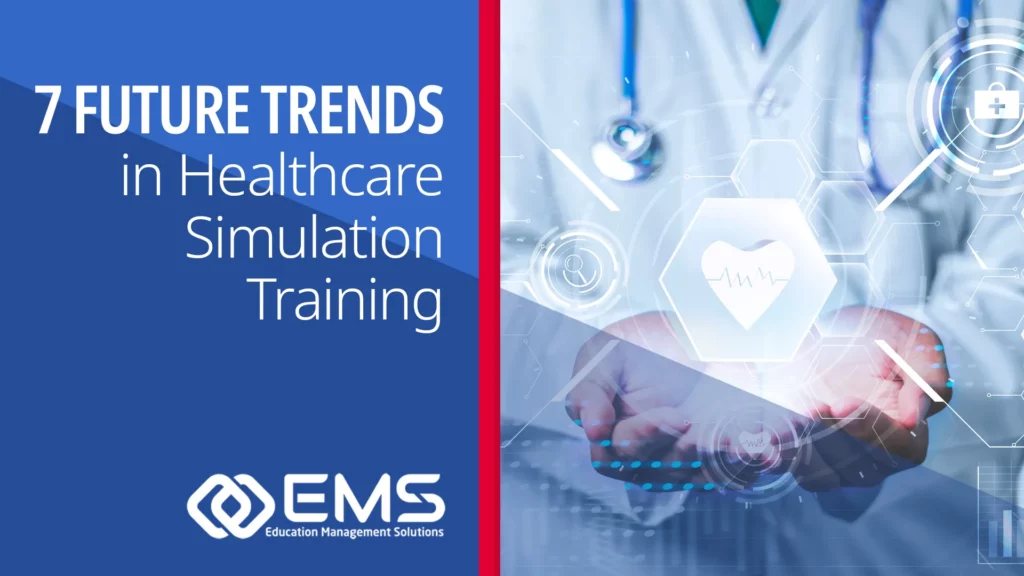Healthcare training methodologies must constantly adapt to prepare future practitioners effectively. While simulation training has become an integral component of medical education, how simulation education is conducted, recorded, and assessed is in constant flux. Here, we explore seven emerging trends in healthcare simulation training and how these advancements will not only enhance educational outcomes but also translate to better patient care.
1. Artificial Intelligence Integration
Artificial Intelligence (AI) holds immense potential to revolutionize healthcare simulation training through algorithms that can create adaptive learning environments, tailoring case scenarios to individual learners based on their performance and knowledge gaps.
For example, AI-driven simulators could present progressively challenging clinical cases, encouraging students to continually advance their competencies and clinical reasoning and decision-making skills. When these AI-enhanced simulation-trained practitioners enter the clinical field, their refined critical thinking abilities will lead to more informed and accurate patient care decisions.
2. Portable Simulation Solutions
Mobile simulation labs and smartphone or tablet-based simulation-based debriefing tools make it possible to bring high-quality training tools to diverse settings, including a wide variety of in-situ environments for emergency medicine, battlefield care, and hospital settings. This accessibility ensures that more types of healthcare students can benefit from simulation training without the geographical constraints of physical classroom.
Healthcare practitioners who have had access to high-quality, portable training solutions will be better prepared to deliver care in more realistic, high-stress situations. This invaluable practice will improve patient outcomes without the need for investment in a traditional sim center.
3. Advanced Haptic Feedback
Haptic feedback technology offers tactile sensations that mimic real-life procedures, allowing students to ‘feel’ the subtleties of surgical interventions and diagnostic procedures. Enhanced haptic feedback in simulations helps learners develop fine motor skills and a better understanding of the force and technique required in clinical procedures.
Surgeons and other clinical practitioners who have trained with advanced haptic feedback will perform procedures with greater precision and sensitivity, reducing the likelihood of errors. For instance, a surgeon who has honed their skills on a haptic-enabled simulator will perform minimally invasive surgeries with improved accuracy, leading to quicker patient recovery times and fewer complications.
4. Competency Tracking Integration
Competency tracking tools integrated into simulation training programs enable real-time assessment and feedback on learner performance. These systems can track progress on key competencies, identifying areas requiring further development and ensuring that students meet educational standards before advancing.
Continuous competency assessment ensures that only those who demonstrate requisite levels of proficiency at a wide swath of competencies will proceed to clinical practice, enhancing overall patient safety and outcomes.
5. Big Data and Analytics
The use of big data and analytics in simulation training provides valuable insights into student performance, curriculum efficacy, and training gaps. Schools can analyze large datasets to refine educational strategies, adopt best practices, and individualize learning experiences.
This data-driven approach ensures that practitioners are up-to-date with the latest clinical guidelines and practices, resulting in higher quality care.
6. Virtual and Augmented Reality
Virtual Reality (VR) and Augmented Reality (AR) offer immersive and interactive training experiences. VR can simulate realistic clinical environments for procedural practice, whereas AR can overlay digital information onto real-world scenarios, enhancing situational awareness and decision-making. These technologies enable risk-free practice of complex and rare procedures.
7. Cloud-Based Simulation
Cloud-based simulation platforms enable healthcare education programs to deliver scalable, flexible, and collaborative learning experiences. By storing simulation scenarios and performance data in the cloud, institutions can easily update content, manage access, and facilitate peer-to-peer learning without the additional cost and physical footprint of a traditional hardware-based on-premises installation. Additionally, these platforms allow learners to access simulations from any location with internet access, thereby overcoming traditional geographic learning limitations.
Leveraging Future Trends for Better Healthcare
The future of healthcare simulation training is brimming with innovations that promise to transform educational methodologies and, ultimately, patient care. By holistically integrating some of the technologies listed above into their training programs, healthcare educators can ensure that their students are exceptionally well-prepared which will translate into improved patient outcomes.
With these advancements coming to the fore, choosing the right partner to manage your simulation management technology becomes critical. Education Management Solutions (EMS) has been at the forefront of emerging simulation trends for more than 30 years, providing solutions for educators that truly enhance their programs. Discover how EMS’s expertise propels institutions forward into the future of healthcare education.

